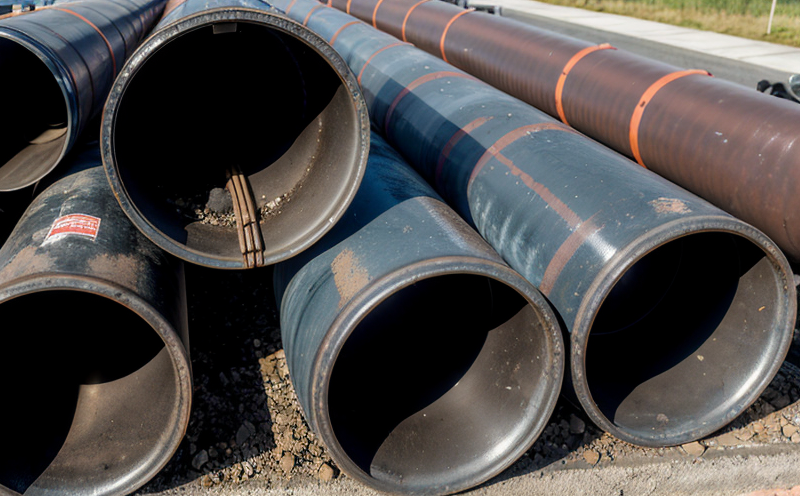DIN EN 1452 Testing of Plastic Pressure Pipes
The DIN EN 1452 standard is a critical set of specifications for ensuring the quality, safety, and durability of plastic pressure pipes. This testing protocol addresses the mechanical properties, chemical resistance, and thermal stability of polymeric materials used in pressure systems. This service provides comprehensive testing according to DIN EN 1452 to ensure that plastic pipes meet the stringent requirements necessary for safe and reliable operation.
The standard covers a wide range of tests including hydrostatic strength testing, burst testing, flexural modulus determination, and dimensional stability checks under various temperature conditions. It is particularly important in sectors such as water supply networks, industrial process piping, and building construction where plastic pipes are widely used due to their corrosion resistance, light weight, and flexibility.
Before initiating any test according to DIN EN 1452, the specimen preparation must be meticulously followed. This involves cutting samples from the pipe material that accurately represent the intended use of the product. The specimens should then undergo conditioning to ensure they are at a standard temperature and humidity level before testing begins.
The testing process itself is highly detailed and requires precise instrumentation. Hydrostatic strength tests measure the maximum pressure a pipe can withstand without failure, while burst tests determine the point at which the pipe will rupture under increasing pressure. Flexural modulus tests assess the material's stiffness, ensuring it can maintain its shape under stress.
Dimensional stability checks are conducted to ensure that the pipes do not deform or lose their dimensions over time, especially when exposed to temperature variations typical of operational environments. These tests are crucial for preventing leaks and maintaining the integrity of the pressure system.
The results from these tests must be analyzed meticulously to ensure they meet the acceptance criteria specified in DIN EN 1452. This includes not only passing the mechanical strength requirements but also ensuring that the chemical composition is within acceptable limits, and that thermal stability is maintained at operational temperatures.
Our laboratory uses state-of-the-art equipment calibrated according to international standards such as ISO 9001 for quality assurance. Our experienced technicians ensure that every test adheres strictly to DIN EN 1452 guidelines, providing reliable and accurate results. The final report includes detailed data from each test, along with a comprehensive interpretation of the findings.
Scope and Methodology
| Test Type | Description |
|---|---|
| Hydrostatic Strength Test | Determines the maximum pressure a pipe can withstand without failure. |
| Burst Test | Evaluates the point at which the pipe will rupture under increasing pressure. |
| Flexural Modulus Test | Metric for material stiffness ensuring it maintains its shape under stress. |
| Dimensional Stability Check | Ensures pipes do not deform or lose dimensions over time, especially at varying temperatures. |
The methodology involves detailed specimen preparation and conditioning to ensure accurate test results. The specimens are cut from the pipe material in a manner that accurately represents its intended use. They undergo conditioning to standardize temperature and humidity levels before testing begins.
Testing equipment is calibrated according to international standards like ISO 9001 for quality assurance. Our technicians follow DIN EN 1452 guidelines meticulously, ensuring reliable and accurate results. The final report includes detailed data from each test along with a comprehensive interpretation of the findings.
The DIN EN 1452 testing protocol is essential for various industries that rely on plastic pressure pipes for safe and efficient operation. In water supply networks, this ensures the integrity of the system by preventing leaks and maintaining pressure levels. For industrial processes, it guarantees that piping systems can withstand harsh conditions without failure.
In building construction, the use of DIN EN 1452-tested plastic pipes ensures compliance with safety regulations and standards. This is particularly important in high-rise buildings where water distribution and drainage systems must be robust to handle increased demand and pressure differences.
Use Cases and Application Examples
- Water Supply Networks: Ensuring pipes can withstand high pressures without failure, crucial for maintaining water distribution systems.
- Industrial Processes: Guaranteeing that piping systems in chemical plants or power generation facilities are robust enough to handle harsh environments and chemicals.
- Building Construction: Providing safe and reliable drainage and water supply solutions in high-rise buildings, ensuring compliance with safety regulations.
| Application Example | Description |
|---|---|
| Water Supply Network Installation | Testing pipes to ensure they can maintain pressure and resist corrosion over long periods. |
| Chemical Plant Piping | Evaluating the durability of plastic pipes in environments exposed to corrosive chemicals. |
| High-Rise Building Drainage System | Ensuring that drainage systems can handle increased water flow and pressure differences effectively. |





